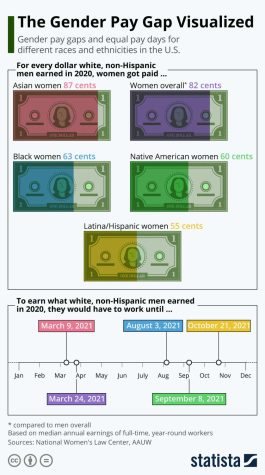New York City transparency law promotes salary equity

Recent pay transparency laws in New York City require employers to disclose salary ranges for each job opening they have whether it’s an online posting or printed on a bulletin board. As of Nov. 1, employees no longer have to secretly discuss and compare salaries fearing punishment from their bosses.
Sophomore June Dalton said, “I think that it’s very important for people who do the same job to make the same amount of money because otherwise, it can just be really unfair based on race, gender and literally anything else.”
She said that if someone goes above and beyond at that one job or if an employee does things they weren’t required to, more pay makes sense.
But if two employees are doing the exact same thing at the same level, “then it just isn’t fair,” Dalton said.
Businesses hiring workers are required to post the minimum and maximum salary range for any job; but within the first week of New York’s transparency laws, workers began to see unrealistically broad ranges from employers.
According to CNBC Make It, “Citigroup listed several jobs with a range of $0 to $2 million… a revised entry for a post for a client services officer listed the salary range between $61,710 and $155,290 as of Wednesday, before it was taken down.”
Part of the transparency law requires “good faith,” it represents how much a company is willing to pay its employees depending on factors like the candidate’s industry knowledge, experience and technical and communication skills.
Junior Arden Lillemoe said, “I think it reasonable for employees… going above and beyond or have been working somewhere for a long time to have a higher wage.”
Although factors such as skill level and experience do affect salaries to a certain extent, it is difficult to consider a good faith range larger than $100,000 to be an accurate representation of the range. To avoid this direct comparison, companies attempt to find loopholes around this law and in some cases, they choose to stop advertising their job openings altogether.
According to The Minnesota Department of Labor and Industry, “Under the Minnesota Wage Disclosure Protection law, you have the right to tell any person the amount of your own wages. Your employer cannot retaliate against you for disclosing your own wages.”
When asked what pay transparency looks like at SPA, the Director of Human Resources declined to comment.
Minnesota laws regarding wage disclosure are aimed at preventing existing gender and racial discrimination.
While there is no pay transparency law in the state or the Twin Cities, the MN Office of the Revisor includes the full text of protections for Equal Pay Sec. 181.66 and Wage Disclosure Sec. 181.172.
The first guarantees equal pay for equal work and outlines the process to bring forward a complaint if it is not being followed by an employer. The wage disclosure simply states that an employee can share how much money they make without fear of repercussion or being fired by an employer.
Time’s Up states that “While on average, women in the United States are paid 82 cents for every dollar paid to men, Latinx women earn 54 cents, Native American women earn 57 cents, Black women earn 62 cents, and AAPI women earn 90 cents on the dollar of a white man.”
“This is something only fixable if we fix the system which is inherently racist and sexist,” Lillemoe said. “That would not be something as easy as changing a policy, but it is possible for the system to change over time with active effort. We can start by spreading awareness of how the system treats nonwhite people [and other minorities],” Lillemoe said.
These transparency laws attempt to achieve pay equity by allowing employees to disclose their wages displaying a clear pay gap which lowers the risk of pay discrimination. In hopes of achieving pay equity, more states have begun to adopt similar laws.
Hi, I'm Annie Bai (she/her), I am the current In Depth editor for The Rubicon print. This is my third year on staff and last year, I was the Good Question...